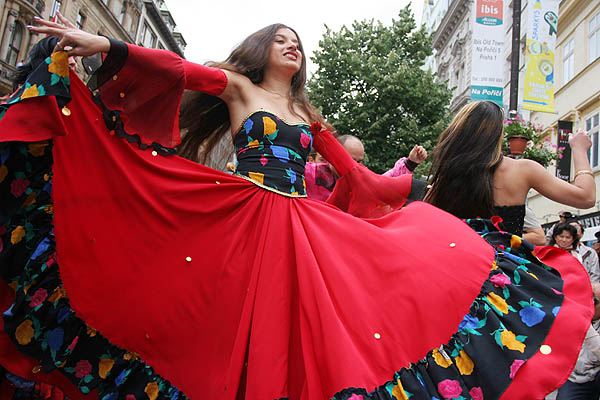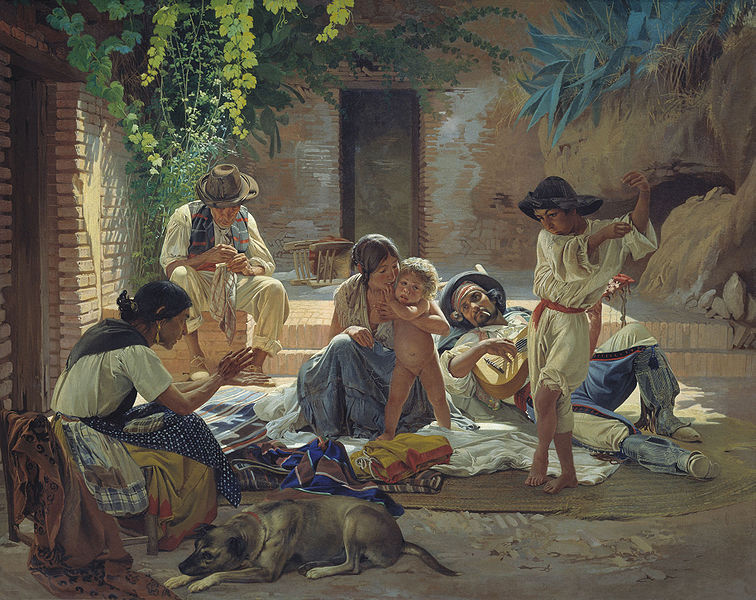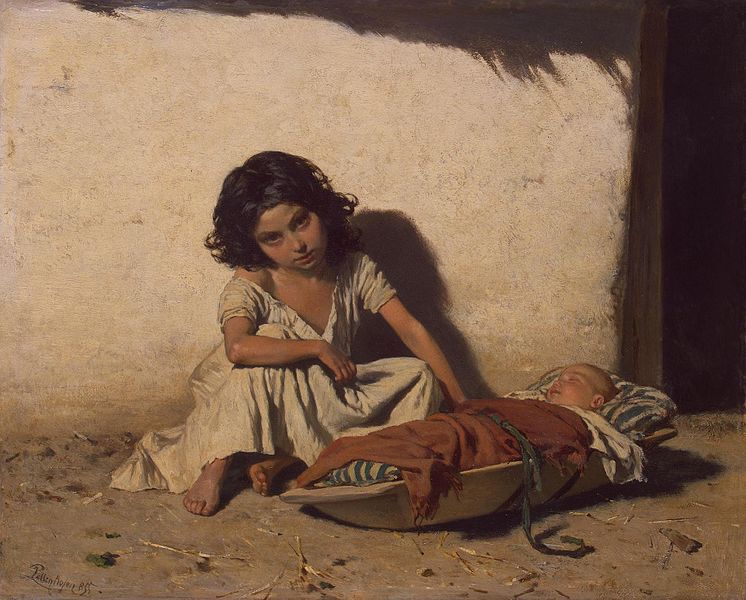The Romani: from India to the World, Part 2 Posted by Rachael on Feb 9, 2019 in Hindi Language
In last week’s blog, we discussed the Romani (Romany or Roma), a group (समूह/samooh) of people from the Northwestern Indian subcontinent (उत्तर-पश्चिमी इंडियन उपमहाद्वीप/uttar-paschimi Indian upmahaadveep) who, about 1,500 years ago, migrated (प्रवास करना/pravaas karnaa) from this region (क्षेत्र/kshetra) and eventually settled (बसना/basnaa) in about 30 countries (देश/desh) worldwide. In this second part of the blog series, we’ll talk about the Romani’s history (इतिहास/itihaas), culture (संस्कृति/sanskriti) and religious beliefs (धार्मिक विश्वास/dhaarmik vishvaas).
Despite their rich culture, remarkable fortitude and ability to adapt to adverse and ever-changing circumstances (परिस्थितियाँ/paristithiyaan, परिस्थिति=singular), the Romani people have known discrimination (भेदभाव/bhedbhaav) and stigma in many of the places to which they’ve traveled and in which they’ve made their homes. In fact, until the gradual abolition of slavery (गुलामी/gulaami) in the mid-1800s in what are today regions of Romania and Moldova, the Romani were sometimes kept as slaves (गुलाम/gulaam); indeed, in medieval Europe, slavery was commonplace and usually targeted the poor, downcast and marginalized members of society as its victims. However, even while slavery was legal in Europe, many Romani continued to travel freely with their wagons, their nomadic lifestyle (ख़ानाबदोश जीवन शैली/khaanaabadosh jeevan shaili or ख़ानाबदोशी=nomadic life) undoubtedly making it more difficult for people to enslave them permanently. Over time, the wagon wheel (पहिया/pahiyaa) became a powerful symbol (प्रतीक/prateek) of the Romani, which embellishes their flag (झंडा/jhandaa) today. This flag was created in 1933 and later accepted by the World Romani Congress in 1971 as a symbol of the Romani people as a whole.
In addition to being subjected to slavery, the Romani people were victims (शिकार/shikaar) of ethnic cleansing, abduction of their children, forced labor, expulsion from the communities in which they attempted to settle and all manner of horrific violence (हिंसा/himsaa). In WWII, they suffered at the hands of the Nazis who forced them to live in concentration camps where they performed grueling labor and were subjected to genocide (नरसंहार/narsamhaar), a process that decimated numerous Romani communities (समुदाय/samudaay) and is known as “Porajmos” (or “The Devouring”) in Romani. In what is now the Czech Republic, the extermination of the Romani communities living there during WWII was so severe that an entire language, Bohemian Romani, became extinct. Even after the war had ended, the suffering (पीड़ा/peeraa) of the Romani scarcely ceased and discrimination against them continues today as they are targeted as scapegoats for a variety of modern ills.
Interestingly, there are numerous parallels (समानताएँ/samaantaae=similarities) between Indian and Romani culture. The Romani highly value community spirit and the extended family, preferring to live with numerous generations (पीढ़ियाँ/peeriyaan, पीढ़ी=singular) close together. Additionally, it is common for men and women to marry at a young age and, indeed, this has given rise to controversy (विवाद/vivaad) over the practice of child marriage (बाल विवाह/baal vivaah). Unlike some dowry practices (दहेज की प्रथाएँ/dahej ki prathaae) in North India today, the male side must pay a bride price to the bride’s parents as part of the wedding arrangements in traditional Romani communities (this practice is not observed by all). Yet, like many North Indian households, once the bride and groom are married, the bride joins her husband’s family, where she may work her way up the hierarchy by becoming a mother and, later on, a senior wife. Within the extended family, however, it is generally the oldest male who holds the most authority.
Additionally, traditional Romani groups practice purity (पवित्रता/pavitrataa or शुद्धता/shuddhtaa) injunctions similar to those observed by traditional Hindus, such as considering certain parts of the body to be impure (अशुद्ध/ashudd or अपवित्र/apavitra) (namely, the lower half of the body) and washing clothes for those parts of the body separately from other clothes as well as washing eating utensils separately. Moreover, childbirth is considered impure so it often occurs outside a person’s dwelling place and, after giving birth, the mother is considered impure for a period of time as well. Similarly, death (मौत/maut or मृत्यु/mrityu) incurs impurity onto the deceased person’s family, who remain isolated from society for a period of time after their relative’s death. Yet, unlike most North Indian Hindus, the Romani typically bury their dead.
Most fascinating, perhaps, is that the Romani have a term for their all-encompassing way of life and culture: Romanipen. This term does not refer to any particular cultural practice but rather to the Romani way of life and perspective (दृष्टिकोण/drishtikon) and the fortitude and verve needed to keep moving forward despite societal pressure (समाजिक दबाव/samaajik dabaav) to conform – this term may even be described as a state of being or life philosophy (दर्शन/darshan) that differentiates a true Romani from a gadjo or outsider (पराया/paraayaa or अजनबी/ajnabi). Romanipen is an important concept in the Romani cultural worldview but, at the same time, it is not guaranteed merely because one is born a Romani. A Romani who does not respect the cultural practices of his community and distances himself from this way of life is thought to have lost this essence (गुण/gun=quality), while a person who has been adopted into this way of life or has intermarried into the community can attain this essence if they respect the Romani’s cultural practices, learn from their elders and embody the spirit of Romanipen.
Many Romani religious practices (धार्मिक प्रथाएँ/dhaarmik prathaae) have their roots (मूल/mool or जड़/jar) in a variety of Hinduism known as “Shaktism” which stipulates that a female consort is necessary for the worship of a god, meaning that prayer (प्रार्थना/praarthnaa) is conducted through a female medium but is ultimately directed toward the male deity. Yet, the Romani’s nomadic nature and residence in a variety of countries has forced them to adapt their Hindu beliefs to a variety of other religions (धर्म/dharm), such as Christianity and Islam, in case a religious ceremony such as a baptism or funeral was ever required in their country of residence. Today, in fact, most Romani identify as Christian. The result of this adaptation of Hinduism to other religions is a fascinating syncretistic belief system, one interesting example of which is Saint Sarah or Sara e Kali, which is a Christian remodeling of the Hindu goddess (देवी/devi) Kali. This saint possesses a shrine at Saintes-Maries-de-la-Mer in France and is envisioned not only as a Christian saint-cum-Hindu-goddess but as emblematic of the Romani people’s unshakeable link to the Hinduism of their ancestors (पुर्वज/purvaj or पुरखा/purkhaa) and their origins in the subcontinent.

Build vocabulary, practice pronunciation, and more with Transparent Language Online. Available anytime, anywhere, on any device.






